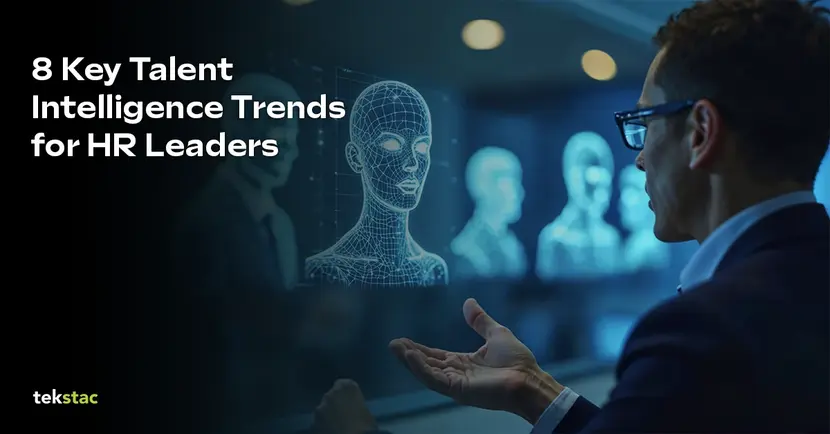8 Talent Intelligence Trends Every HR Leader Should Know

How Does Talent Intelligence Help HR?
Imagine you’re preparing for a big family gathering. You would ensure that there’s enough food, drinks, and entertainment for everyone. If you don’t prepare well, you might end up scrambling at the last minute to guess what everyone likes or needs.
However, if you had access to a few years’ data—knowing which of the dishes were popular the year before, how many drinkers of soda versus juice attend, and what games or activities get everyone engaged—a lot more planning would occur because you could proactively consider everyone’s preferences and things just would go smoothly and become enjoyable.
This is the power of talent intelligence for HR leaders: leveraging data and analytics to make better decisions, anticipate future needs, and proactively manage your workforce. It is somewhat like planning for that family gathering; to anticipate problems, optimize strategies, and ensure the organization’s preparedness for the future. This article delves into 8 key talent intelligence trends shaping the HR landscape.
8 Key Talent Intelligence Trends
1. The Emergence of AI in Talent Analytics
Artificial intelligence transforms human resources leaders’ talent management approaches. It allows organizations to automate data collection and analysis across the workforce, from employee skills and performance metrics to engagement levels, providing a comprehensive view of the talent landscape.
HR leaders are increasingly using AI for deeper insights into the capabilities of their workforce, predicting turnover, and making specific areas for improvement. Such AI-powered platforms aid not only in streamlining hiring but also in seeing whether talent strategies are moving hand-in-hand with the overall business goals. They use these tools to make the decision-making process data-informed, thereby improving employee performance while reducing bias in recruiting.
2. Predictive Analytics for Proactive Workforce Management
Predictive analytics will enable the HR leader to foresee future challenges in the workforce before they happen. By analyzing past performance, historical data, and current trends, predictive tools enable HR teams to spot early signs of issues such as rising employee attrition, skills shortages, or workforce imbalances.
This proactive approach enables HR to take action before problems escalate, ensuring that business operations remain smooth and employee morale stays high. With predictive analytics, HR teams can also forecast future hiring needs and create strategies to fill gaps in skills and leadership, all while boosting overall workforce engagement.
3. The Integration of External Labor Market Data
Organizations are no longer relying on internal workforce data to make talent decisions. Integration of external labor market data is becoming increasingly important for HR leaders who need a full picture of talent availability, salary benchmarks, and emerging skills in the market.
Leaders will be able to understand and comprehend the local hiring pattern, compensation level, and shifting skills, bringing together internal analytics and external labor market insight. This ability helps in constructing competitive acquisition strategies for talent and further helps in revising retention policies to the real-life market perspective.
4. Skills-based hiring over Degree-based Hiring
The job market is a thing of the past, migrating towards skills-based hiring against degrees-based hiring. Hands-on practical experience is now prioritized over academics because there are talent intelligence tools now helping HR leaders sort applicants by skills rather than on educational degrees.
HR leaders can use assessments, simulations, and other performance-based metrics for fair and effective evaluations. The shift in skill-based hiring is actually allowing organizations to build a diverse and effective workforce as they get the right people into the right jobs according to their competencies.
5. Personalized Employee Development Plans
Talent intelligence transforms how organizations approach employee development, taking it from one-size-fits-all learning and growth. With talent intelligence tools now, HR leaders are using their understanding to develop tailored and personal plans for each employee on growth. It considers each person’s strengths, weaknesses, and career goals to advise training, mentorship, and growth opportunities tailor-made to fit the individual employee’s needs.
Personalized development plans have an impact on boosting engagement for employees as well as ensuring that individual growth is tied to the goals of an organization. Consequently, businesses are observing improved retention rates and greater satisfaction by employees; therefore, they possess a more robust workforce better suited for handling future scenarios.
6. Diversity, Equity, and Inclusion (DEI) Analytics
The most important need for organizations has become DEI efforts, and talent intelligence is increasingly playing a very significant role in driving DEI efforts with the help of data used by HR leaders to gauge the diversity of their workforce, monitor hiring practices, and measure the success of their DEI programs.
HR leaders may be able to identify weaknesses in their organization’s ability to attract, retain, or foster diversity, equity, and inclusion by analyzing recruitment and retention data. Corrective action should begin with the elimination of biases within hiring processes, diverse candidate pools, and an inclusive culture that will attract a broader range of talent.
7. Real-Time Talent Monitoring
As hybrid and remote work continue to rise, real-time talent monitoring becomes crucial for HR leaders. Today, modern talent intelligence platforms offer real-time insights into employee performance, engagement, and well-being.
Such practices enable HR leaders to monitor trends from quick-burnout signs, to potential skills gap, or disengagement. This data puts HR in a position where they can take timely responses to support employees through, for example, workload balance, resource enhancement, and mental health support. Hence, real-time monitoring will support HR leaders in keeping staff health and productivity levels irrespective of the location of the workers.
8. Strategic Workforce Planning with Talent Intelligence
Strategic workforce planning becomes necessary for HR leaders to strategically take care of the long-run and sustainable success of the business venture. Talent intelligence platforms currently assist in providing data-based answers that help HR leaders predict workforce needs across marketplace trends, employee demographics, and organizational goals.
Understanding the changing talent landscape enables HR leaders to formulate responsive workforce strategies that will help get the right people in their organization at the right moment. By making data-driven decisions for build-buy-borrow, talent intelligence is helping organizations discover anticipated talent gaps and prepare for forthcoming disruptions, such as the technology revolution or economic crunch. This powers a well thought out succession and skill development planning exercise
Conclusion
In a changing market where competitive pressure on organizations continues to grow, talent intelligence is now a business necessity for every HR leader. AI-driven analytics, predictive insights, and real-time monitoring empower the HR professionals to better plan for their workforce, boost engagement of the employees, and get their organization the right talent that will stick.
By keeping ahead of these trends, HR leaders can stay on top of their industry as opposed to just waiting to react to challenges; hence, they can build an effective workforce ready for tomorrow. By embracing current and future trends, leaders can build agile, diverse, and high-performing teams that drive long-term business success.





